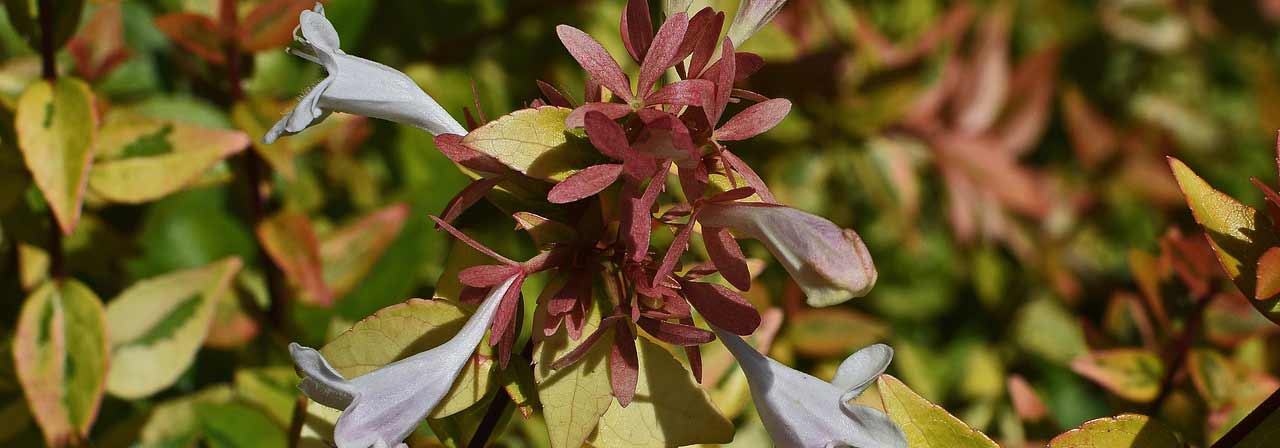
Abelia: planting, growing tips, pruning, care
Contents
Abelia in a nutshell
- Its decorative foliage is highly changeable
- In summer it produces a profusion of white or pink flowers, often fragrant
- Its modest size is well suited to small gardens and to growing in pots
- It is an excellent hedge bush
- Hardy, vigorous, it adapts to all types of soil
A word from our expert
Abelia is a handsome, floriferous bush with decorative foliage, deserving a place in gardens with relatively mild winters. Still not widely grown, it is nevertheless very floriferous and offers continuously from June to October small white or pink flowers which, depending on the varieties, release an extraordinary jasmine and lilac scent.
Its supple, elegant habit, its long and generous flowering followed in autumn by pretty evergreen coppery bracts on foliage that turns purple or reddish, make it a must for summer and late-season displays.
From Abelia grandiflora ‘Kaleidoscope’ to Abelia triflora, via Abelia grandiflora ‘Sherwood’ or the hardiest Abelia x grandiflora ‘Edward Goucher’, all are easy to grow in the garden, in sun or partial shade in any type of well-drained soil and sheltered from prevailing winds.
Hardy down to around -10°C, undemanding, tolerant of drought and pollution, largely disease-free, Abélia is invaluable in town gardens as well as naturalistic gardens.
Its moderate size and dense silhouette allow many uses: in informal or clipped hedges, in beds, along paths, as low hedging, as groundcover, in groups and even in a pot by your entrance to fully enjoy the scented varieties.
Grow this vigorous shrub with sumptuous foliage and dazzling flowering! Our exceptional Abelia collection will surprise you by bringing an elegant, fragrant touch to the garden.
Botany
Botanical data
- Latin name Abelia
- Family Caprifoliaceae
- Common name Abelia
- Flowering June to October
- Height 1.50 to 3 m
- Exposure Sun, partial shade
- Soil type All soils, well-drained
- Hardiness -10°C
Abelia is a shrub of the family Caprifoliaceae native to China. The genus includes around thirty deciduous, semi-evergreen or even evergreen species in mild climates.
Among the most common varieties is Abelia x grandiflora, arguably the best known and most vigorous of all Abelias. It has produced remarkable cultivars and hybrids such as ‘Kaleidoscope’ and ‘Francis Mason’ with variegated foliage, and ‘Sherwood’. There is also Abelia x grandiflora ‘Edward Goucher’, a hybrid variety more cold-hardy — the hardiest of the Abelias (-15°C).
The horticultural hybrid Abelia (x) grandiflora Confetti is a recent selection derived from Abelia (x) grandiflora, itself the result of a cross between Abelia chinensis and Abelia uniflora, valued for its variegated foliage and its compact habit, like the cultivar ‘Prostrata’, also variegated cream.
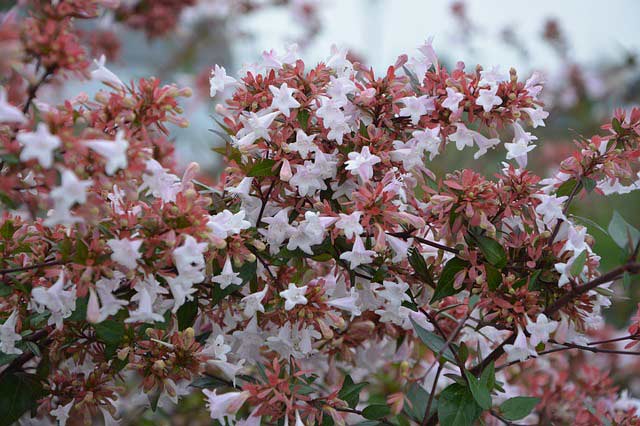
Very floriferous and vigorous Abelia x grandiflora has produced many interesting cultivars
Abelia chinensis, also called Chinese Abelia, emits a powerful fragrance; Abelia floribunda is a species suitable for training against a wall in sun; Abelia triflora is the largest (5 m) and most fragrant, its flowers grouped in threes in the axils of the leaves.
Among the rarer species is the remarkably scented Abelia zanderi, a little-known hardy Chinese species with a compact, spreading habit, and Abelia schumannii, which bears purplish-pink flowers with orange markings.
With a moderately fast growth rate depending on growing conditions, Abelia can reach 2.5 m in height with a spread of 2–3 m in five years. In gardens most remain modest in size and often do not exceed 1.8 m. Variegated varieties grow more slowly and are more delicate.
Dwarf varieties have also recently appeared, such as Abelia (x) Pastel Charm®, from Minier nurseries’ breeding programme, which will not exceed 1 m in any direction.
Habit varies with species and cultivar: arching, gracefully trailing in Abelia ‘Edward Goucher’; semi-trailing in A. ‘Francis Mason’; rounded and supple in Abelia x grandiflora; naturally compact in Abelia (x) grandiflora Sunny Charm®; bushy and flared in Abelia chinensis.
Abelia offers a long, fragrant flowering that lasts through summer, from June to September–October depending on climate, when few shrubs are still in bloom. In spring its flowering shoots are very decorative, but flowering is most abundant in mid-summer: a profusion of small trumpets in pale pink, lilac-pink, light lavender, cherry pink or yellow-gold appears, gathered in terminal panicles at the tips of young shoots.
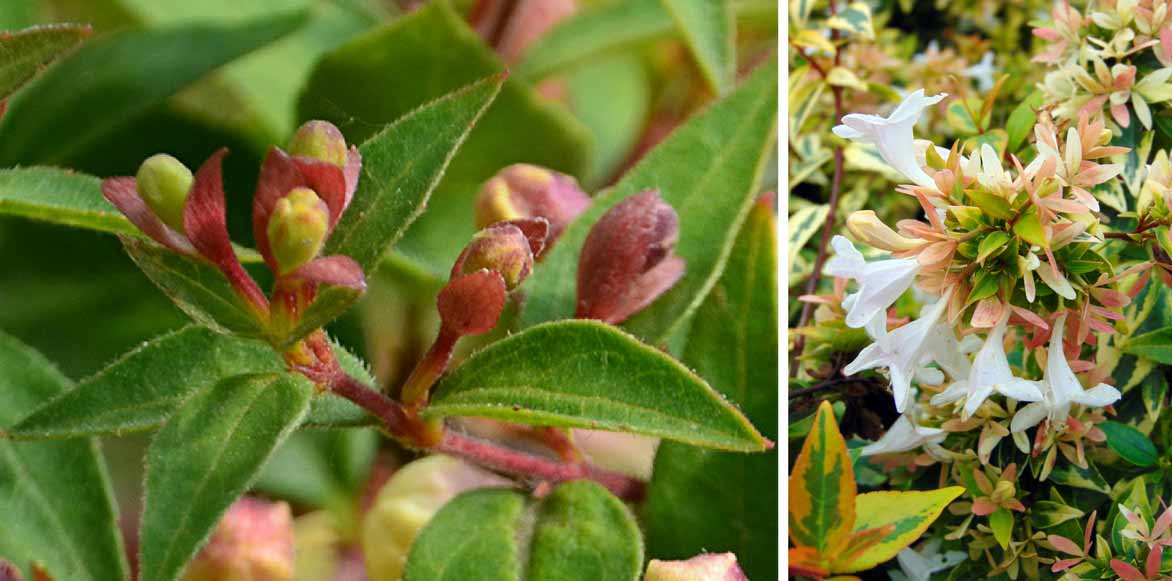
After flowering, blooms are replaced by calyces made of brownish bracts that persist for a long time on the shrub
Sometimes the inside of the corolla — pure white, pink or pale yellow — contrasts nicely with a slightly stronger reverse in powder pink or mauve-white. These countless small tubular corollas (A. floribunda) or funnel-shaped flowers, 2–5 cm long, composed of 2–5 sepals forming a funnel, continue into autumn.
They emit a fresh, sometimes strong scent, of lilac and jasmine mixed with hyacinth that perfumes summer evenings. They attract butterflies and other pollinators. Flowering is followed by fruiting: achenes, each containing a single seed.
Each achene is delicately enclosed in a calyx pink, bright pink, green or brown-red according to the variety, which persists well after the petals fall. Once withered, flowers give way to these calyces made of abundant coppery bracts that remain on the shrub for a long time, harmonising splendidly with the bronze-purplish autumn foliage.

In autumn leaves often take on sumptuous purplish, reddish and bronze tones that persist for a long time on the shoots, unless early frosts remove them
This attractive shrub bears foliage that is more or less evergreen depending on the mildness of the climate. From spring it shows young shoots and often reddish twigs. This arching and particularly decorative branching bears small ovate-to-rounded leaves, more or less dentate, 3–8 cm long, opposite or sometimes clustered in rosettes.
Dark green and glossy through summer in most varieties, leaves are remarkably variegated in some, offering golden tones that change with the seasons: Abelia ‘Confetti’ has light green leaves margined with cream-white that reveal pretty pink hues at first frosts, while Abelia grandiflora ‘Francis Mason’ has dark green leaves variegated with golden yellow.
Low-maintenance and easy to grow, Abelia establishes well in sunny or partially shaded positions, sheltered from cold, drying winter winds. Undemanding about soil type, it prefers light, well-drained soils and tolerates poor and calcareous soils. It copes well with summer drought but dislikes heavy, waterlogged clay soils.
Although hardy, Abelia prefers mild winters and is ideally grown up to Île-de-France and in regions south of the Loire, in Brittany and the south-west where winter temperatures do not fall below -10°C to -12°C, even for the more vigorous grandiflora varieties. It dislikes icy winds and severe frosts. Conversely, it tolerates drought reasonably well and withstands wind and sea spray, making it suitable for coastal gardens. It is a vigorous shrub very resistant to most diseases and pests: no serious enemies are known.
Abelia is a versatile shrub that fits into all garden styles and is excellent in small spaces. It tolerates pollution, making it a fine urban shrub. Its moderate size and dense silhouette allow many uses: in borders planted with asters, Japanese anemones and tricyrtis; as a specimen; in a small copse; as an informal hedge paired with Leycesteria formosa (Desmodium) for a pretty contrast; as a flowering hedge with buddleias, Kolkwitzia, mock-orange, ceanothus, Caryopteris, Berberis, shrub roses or Choisya; as a low hedge for dwarf varieties; and even grown in a large pot by the entrance in regions with mild winters to fully enjoy its scent.
Some varieties such as ‘Confetti’, under 1 m in all dimensions, make excellent groundcovers.
It can be paired with variegated-leaved shrubs such as Cornus or Photinia. Its slightly untidy form provides a handsome contrast with more formal plants like bamboos, pampas grass or Japanese maples.
Read also
Abelia: planting, pruning and careSpecies and main varieties
Abelias present multiple attractions through the seasons. Main selection criteria are flower colour, leaf colours in summer and autumn, mature size and sometimes habit, which can be more or less compact and bushy.
Abelia x grandiflora, a hybrid obtained by cross-breeding Abelia chinensis and A. uniflora, is probably the best-known of the genus and also the most vigorous of all Abelias. Grandiflora varieties are more vigorous but remain hardy only to -10°C. Also widespread is Abelia x grandiflora ‘Edward Goucher’; this small hybrid is the hardiest of Abelias, tolerating lows down to -15°C.
Abelia chinensis, or Chinese abelia, is one of the most floriferous and fragrant. Among rarer ones there is Abelia zanderi, a little-known Chinese species with compact, bushy habit, and its cultivar ‘Little Richard’, and Abelia schumannii, a deciduous shrub with orange-pink flowers.
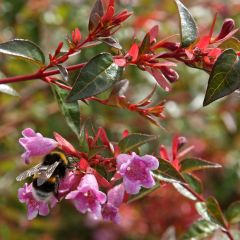
Abelia Edward Goucher
- Flowering time September to November
- Height at maturity 1,80 m
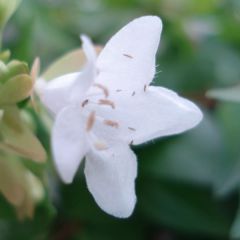
Abelia grandiflora Francis Mason
- Flowering time August to October
- Height at maturity 1,50 m
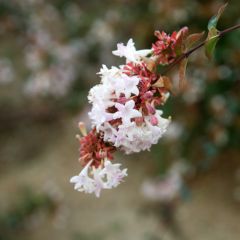
Abelia grandiflora - Abelia with large flowers
- Flowering time August to November
- Height at maturity 2,50 m

Abelia chinensis
- Flowering time September to November
- Height at maturity 2 m
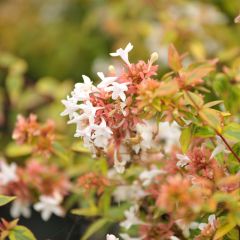
Abelia x grandiflora Kaleidoscope
- Flowering time July to November
- Height at maturity 80 cm
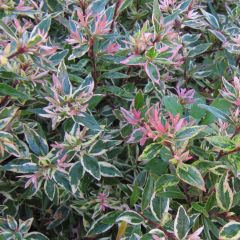
Abelia x grandiflora Confetti
- Flowering time August to November
- Height at maturity 90 cm
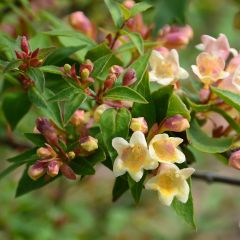
Abelia x grandiflora Sunny Charm MINDUO1
- Flowering time August to November
- Height at maturity 1 m
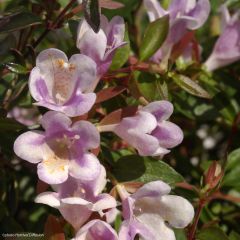
Abelia grandiflora Pastel Charm
- Flowering time August to November
- Height at maturity 1 m
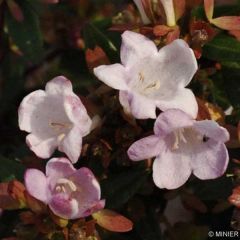
Abelia grandiflora Petite Garden
- Flowering time August to November
- Height at maturity 90 cm
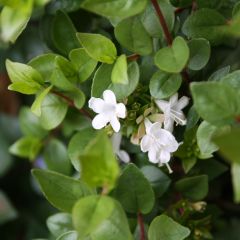
Abelia zanderi Little Richard
- Flowering time August to November
- Height at maturity 60 cm
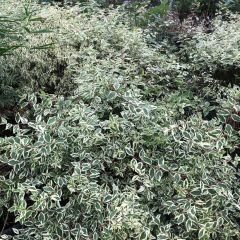
Abelia grandiflora Sparkling Silver
- Flowering time August to November
- Height at maturity 50 cm
Discover other Abelia
View all →Available in 1 sizes
Available in 2 sizes
Available in 1 sizes
Available in 3 sizes
Available in 1 sizes
Available in 3 sizes
Available in 1 sizes
Available in 2 sizes
Available in 1 sizes
Available in 2 sizes
Planting
If it is endowed with average frost hardiness, down to -10/-12°C, Abelia is best sited in regions south of the Loire where winters are fairly mild. It shows good resistance to sea spray. However, it should be planted sheltered from cold, dry winds that damage foliage and flowering, especially when young: train it against a south-facing wall if you wish to try to grow it in a region with harsh winters.
It prefers full sun to flower well but tolerates partial shade.
Undemanding about soil type, it grows in any good, well-drained garden soil, even calcareous, but above all not too wet: it dislikes heavy, compact, waterlogged soils. It likes soils that remain cool, but as it ages it will tolerate occasional summer dryness. In cold areas, a good mulch is recommended for the first winters or in case of exceptional cold.
Often wider than tall, Abelia can be used as a specimen, as an informal flowering or low hedge, in a perennial border or with other shrubs, in association with evergreens with dark or variegated foliage to bring out colours of the flowers, leaves and shoots.
Modest pruning of some varieties allows pot culture on a terrace or balcony to fully enjoy its remarkable summer scent.
→ Discover our article: Growing Abelia in a pot
When to plant?
Plant Abelia either in spring in March or in autumn in October. It can, however, reasonably be planted from February to May in cold regions and rather in autumn in warm regions from September to November, avoiding periods of frost or extreme heat.
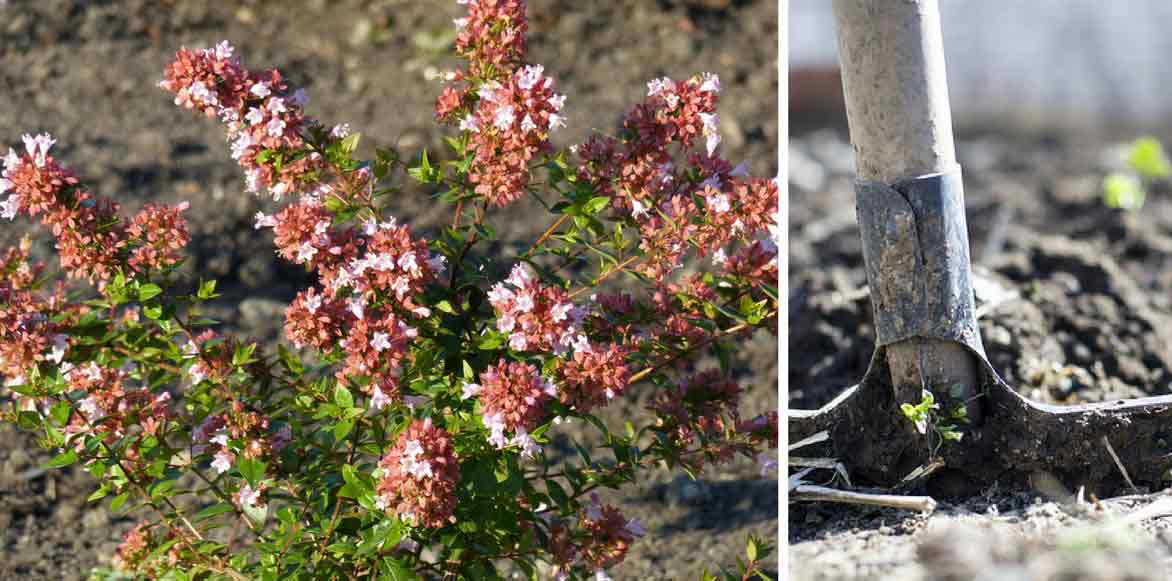
Planting Abelia is very easy: it grows in any good, well-drained soil
How to plant Abelia?
Depending on variety and use, space plants 60 cm apart for low, compact varieties to obtain dense clumps. For taller varieties or for hedging, space plants 80 cm to 1.20 m apart.
- Dig a hole three times wider than the root ball and about 50 cm deep
- Using some of the excavated soil, make a small mound at the bottom of the hole to support the roots
- Mix the remainder half-and-half with potting compost
- Optionally lay a good bed of gravel to ensure perfect drainage
- Place Abelia in the centre of the hole, the collar level with the soil
- Return the excavated soil to enclose the roots and refill the hole
- Keep the shrub upright
- Firm the soil with your foot
- Water well at planting and weekly during the first year after planting
Growing in pots
Growing in pots is possible, especially with varieties of compact growth. Repot every 3 years and prune the shrub regularly to contain its growth. Keep the soil cool in summer, mulch heavily in winter or bring pots indoors to shelter from severe frosts.
Read also
Growing Abelia in a potMaintenance, pruning and care
Undemanding, Abelia is easy to grow and requires little maintenance. It can be easily sheared or trimmed with a hedge trimmer each year, depending on shape you wish to give it (especially when used as a clipped hedge), to maintain a compact, balanced habit, encourage its growth and stimulate its flowering. Prune in late winter, between February and April, before growth resumes: remove crossing, thin or dead branches at their base to keep only most vigorous branches.
→ Also read our advice in our tutorial: How to prune Abelia?
In prolonged drought, and during first two years, monitor water needs of your shrub.
It is preferable to mulch generously around base before winter and do so during first 3 years after planting. A winter fleece can prove useful to protect it from severe frosts.
Potential pests and diseases
Abelia never gets ill, it is immune to most diseases and parasitic attacks.
Propagation
The simplest and quickest method to multiply Abélia is propagation by cuttings.
Propagation by cuttings
Multiplication is done by semi-woody cuttings (when shoots begin to turn into hard wood) in July–August:
- After flowering, take cuttings 6 to 12 cm long
- Insert the cuttings three-quarters of their length into a light, well-draining substrate (turf and river sand) kept moist, spacing them 5 cm apart
- Place the seed tray or pot in shade outdoors until autumn, under a small greenhouse then under a cold frame during winter
- Plant out in the ground the following spring

Abélia is very easy to propagate in summer
⇒ To learn more, see our illustrated tutorial: How to propagate Abelia?
Pairing ideas
If you like Abelia for ease of cultivation, it is also much appreciated for its very ornamental appearance for much of the year: in summer it is covered with a profusion of fragrant white or pink flowers and then its green or golden foliage takes on fiery copper or bronze tones in autumn.
Abelia works well in groups with other shrubs or alone, in a mixed border with perennials as well as in an informal or clipped hedge and even as groundcover for the lowest varieties. It provides a beautiful contrast with warm colours, gold-variegated foliage and shrubs with red‑orange leaves such as Photinia.
In a flowering hedge, it will be the perfect companion to Pyracanthas, a Caryopteris, Kolkwitzia amabilis or “beauty bush”, Deutzia, Berberis, mock orange, lilacs, shrub roses, or near a Buddleia.
It looks especially attractive alongside flowering and ornamental‑foliage shrubs that will showcase its flowering and flamboyant autumn foliage — or, by contrast, it can provide striking contrasts; Choisya, Leycesteria formosa, Spireas, Euonymus, Viburnums or Dogwoods.
Its somewhat untidy silhouette will benefit from being placed beside plants with a more upright habit such as bamboos, pampas grasses, upright panic grasses or Japanese maples.
In a summer border, pair it with Delphiniums, Agastaches, hardy geraniums… In autumn, associate it with Asters, Japanese anemones, Tricyrtis, Heleniums…
It also grows very well in a large pot on the terrace to scent summer evenings.

Abelia grandiflora-Buddleia davidii ‘Nahno-Blue’-Cornus sanguinea ‘Magic Flame’
→ More ideas for pairing with Abelia in our advice sheet on Abelia
To learn more
Discover :
- Our extensive range of Abelias
- As well as our practical advice on our page: “Abelia: planting, pruning and care”, How to choose an Abelia?
- Our advice: Pairing an Abelia
- Discover our varieties :
-
- 9 Abelias for a flowering hedge !
- 7 dwarf Abelias
- 5 variegated Abelias
- 7 Abelias with fragrant flowers for an enchanting garden
- Abelias by flower colour: 7 Abelias with white flowers for a bright garden; Top 7 Abelias with pink flowers to brighten your garden
- Subscribe!
- Contents

































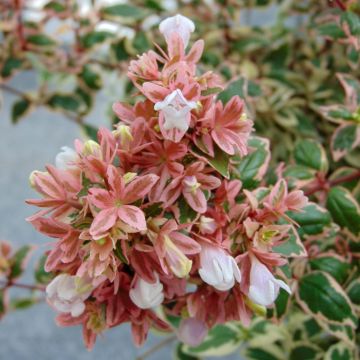
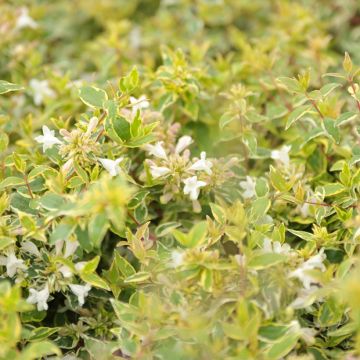



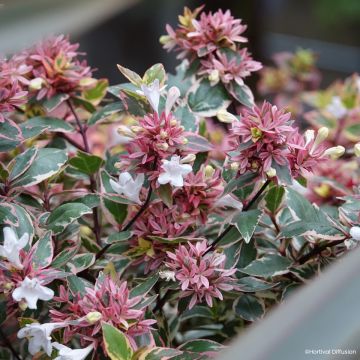

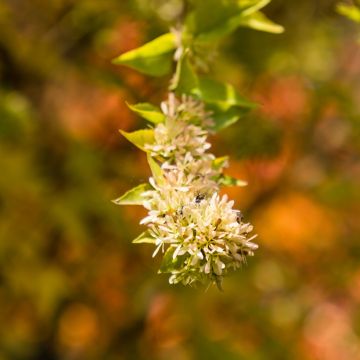
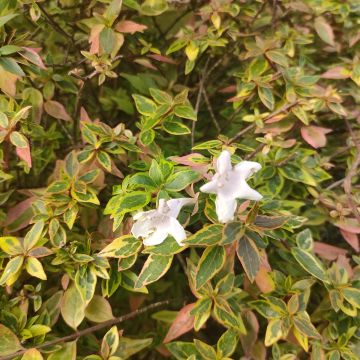
Comments